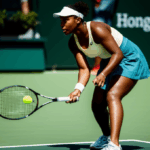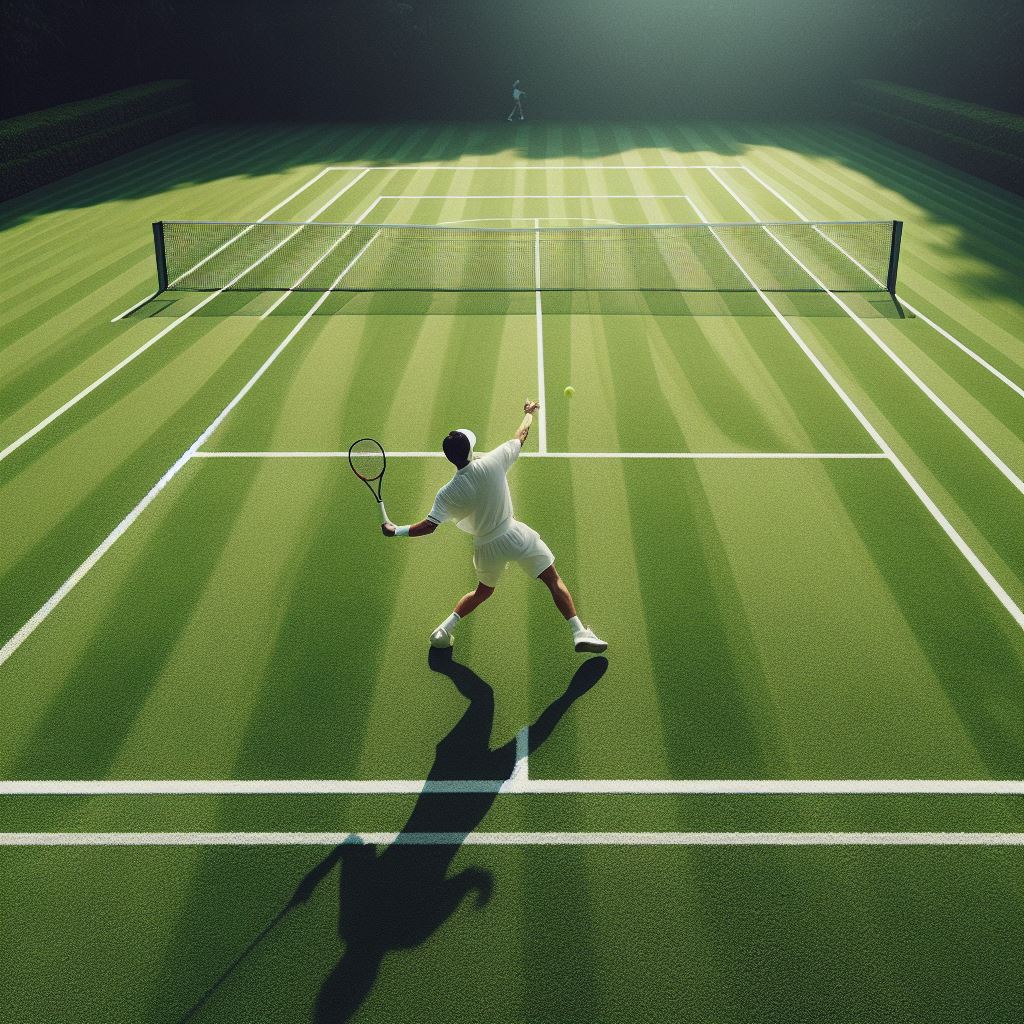Unlock the explosive potential of your forehand with our expert guide on mastering the art of power.
Like a well-oiled machine, your forehand can become a force to be reckoned with, propelling your tennis game to new heights.
This comprehensive article will equip you with the technical know-how, experienced insights, and professional techniques needed to enhance your grip, stance, body rotation, weight transfer, swing technique, follow-through, footwork, court positioning, and even strengthen your conditioning.
Prepare to unleash a forehand that commands attention and leaves opponents in awe.
Key Takeaways
- Eastern grip allows for a balance of power and control in the forehand
- Correct stance, such as open or closed stance, is crucial for effective forehand technique
- Body rotation, weight transfer, and wrist snap generate power and spin in the forehand
- Footwork, court positioning, and shot selection play crucial roles in forehand effectiveness
Grip and Stance
The grip and stance are fundamental elements of the forehand technique that contribute to a player’s power and control on the court. When it comes to the forehand, the grip is crucial in determining the level of control and power that can be generated.
The most commonly used grip for the forehand is the Eastern grip, where the base knuckle of the index finger is placed on the third bevel of the racket handle. This grip allows for a balanced combination of power and control, as it allows the player to easily generate racket head speed while maintaining stability.
In addition to the grip, the correct stance is essential for an effective forehand technique. The open stance is widely used in modern tennis, where the player starts with the front foot pointing towards the net and the back foot slightly behind. This stance allows for quick weight transfer and rotation of the hips, resulting in increased power and stability.
However, the closed stance can also be used in certain situations, especially when the player needs to generate more power or when dealing with wide shots.
Body Rotation and Weight Transfer
Body rotation and weight transfer are essential components of a powerful and effective forehand technique. To generate maximum power and control, players must engage their hips and core while executing the shot. Hip rotation allows for a greater coil and uncoil motion, enabling players to generate more torque and power. By engaging the core muscles, players stabilize their bodies and transfer the generated power efficiently from the lower to the upper body.
In addition to hip rotation and core engagement, arm extension and wrist snap play crucial roles in maximizing the effectiveness of the forehand shot. As the player initiates the forward swing, extending the arm fully allows for greater reach and racket head speed. This extension, coupled with a quick wrist snap, adds extra power and spin to the shot.
Proper body rotation and weight transfer, combined with arm extension and wrist snap, enable players to generate tremendous power and control over their forehand shots. It is important to note that mastering these techniques requires practice and refinement. Players should focus on developing the coordination and timing necessary to execute these movements seamlessly.
Swing Technique and Follow-through
A crucial aspect of mastering the forehand power lies in the precise execution of the swing technique and follow-through. Timing and racket head speed are key factors that contribute to generating maximum power and control in your shots. To achieve optimal timing, it is essential to synchronize the swing with the incoming ball. This requires a keen sense of anticipation and quick reaction time. By carefully observing the ball’s trajectory and adjusting your swing accordingly, you can ensure that the racket makes contact with the ball at the ideal moment. Additionally, maintaining a high racket head speed throughout the swing is crucial for generating power. This can be achieved by employing proper technique and utilizing the kinetic chain, where the energy generated from the lower body is transferred to the upper body and ultimately to the racket.
Shot selection and shot placement also play a vital role in executing a powerful forehand. By strategically choosing the right shot for each situation and placing it accurately, you can put pressure on your opponent and gain control of the point. This involves analyzing the court positioning of your opponent, identifying their weaknesses, and exploiting them with well-placed shots. Moreover, by varying the speed, spin, and angle of your shots, you can keep your opponent off balance and force errors.
Mastering the swing technique and follow-through is just one aspect of a complete forehand. The next section will discuss the crucial role of footwork and court positioning in maximizing the effectiveness of your forehand shots.
Footwork and Court Positioning
To maximize the effectiveness of your forehand shots, it is crucial to master the art of footwork and court positioning. Proper footwork allows you to get into the ideal position to hit the ball and generate power, while court positioning ensures that you are in the right spot to cover the court effectively.
Here are three key aspects to consider when working on your footwork and court positioning:
- Agility training and speed improvement: Agility is essential in tennis as it enables you to quickly change direction and react to different shots. Incorporate drills that focus on lateral movement, quick turns, and explosive acceleration to improve your agility and speed on the court. This will help you reach the ball faster and maintain balance while hitting your forehand shots.
- Defensive positioning and shot selection: In certain situations, you may find yourself on the defensive, having to retrieve difficult shots. It is important to position yourself strategically on the court to give yourself the best chance of returning the ball effectively. Anticipate your opponent’s shots and adjust your positioning accordingly. Additionally, choose your shots wisely, opting for defensive shots when necessary to regain control of the point.
- Offensive court positioning: When you have the opportunity to hit an aggressive forehand, positioning yourself closer to the baseline can help you generate more power and control over the shot. This allows for a shorter swing path and enables you to take the ball early, dictating the pace of the rally.
Mastering footwork and court positioning will greatly enhance your ability to execute powerful forehand shots consistently. Practice these techniques diligently to elevate your game to the next level.
Strength and Conditioning Exercises
Developing a robust strength and conditioning routine is crucial for enhancing your forehand power and overall performance on the tennis court. When it comes to strength training, one effective method is plyometric training.
This form of exercise focuses on improving explosive power and muscle contraction speed, both of which are essential for generating maximum force in your forehand strokes.
Plyometric exercises involve rapid stretching and contracting of muscles, such as jump squats, box jumps, and medicine ball throws. These exercises not only increase your lower body strength but also improve your agility and coordination, allowing you to move quickly and efficiently around the court.
In addition to plyometric training, core strengthening exercises are also vital for maximizing your forehand power. A strong core provides stability and allows for better transfer of energy from your lower body to your upper body during the stroke.
Planks, Russian twists, and medicine ball slams are some examples of effective core exercises that you can incorporate into your strength and conditioning routine.
Frequently Asked Questions
How Can I Improve My Tennis Forehand Without Changing My Grip and Stance?
Improving accuracy and increasing racket head speed in your tennis forehand can be achieved without changing your grip and stance. By focusing on proper weight transfer, timing, and rotation, you can generate more power and control in your shots.
What Are Some Common Mistakes in Body Rotation and Weight Transfer During a Forehand Stroke?
Common mistakes in body rotation and weight transfer during a forehand stroke include a lack of hip rotation and improper weight transfer. These errors can hinder power generation and affect shot accuracy.
Are There Any Specific Drills or Exercises to Help Me Perfect My Swing Technique and Follow-Through?
To perfect your swing technique and follow-through on a forehand stroke, specific drills and exercises can be beneficial. These drills focus on the importance of wrist snap for maximum power and incorporating racket head speed for a more powerful shot.
How Can I Improve My Footwork and Court Positioning to Better Execute Forehand Shots?
Improving footwork and court positioning is crucial for executing forehand shots. By focusing on agility and strengthening core muscles, players can enhance their ability to move quickly and efficiently, maximizing their shot execution and overall performance.
Are There Any Specific Strength and Conditioning Exercises That Focus on Improving Forehand Power in Tennis?
Strength and conditioning exercises play a crucial role in enhancing forehand power in tennis. By focusing on specific exercises that target the muscles involved in the forehand stroke, players can develop the necessary strength and explosive power required for a powerful and effective shot.
Conclusion
In conclusion, mastering the forehand power in tennis requires a combination of proper grip, stance, body rotation, weight transfer, swing technique, follow-through, footwork, court positioning, as well as strength and conditioning exercises.
By incorporating these pro techniques into your training routine, you can significantly enhance your forehand power and overall performance on the court.
One interesting statistic to note is that professional tennis players generate an average forehand speed of over 75 miles per hour, showcasing the immense power and skill required in executing this shot.








No Comment! Be the first one.